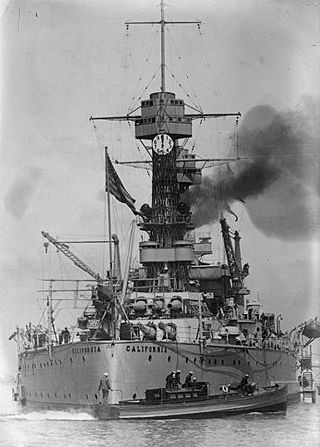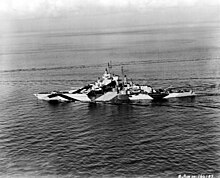USS California (BB-44)
| history |
|
|---|---|
| Keel laying: | October 25, 1916 |
| Launch: | November 20, 1919 |
| Commissioning: | August 10, 1921 |
| Decommissioning: | February 14, 1947 |
| Removed from the register of ships: | March 1, 1959 |
| Fate: | sold for scrapping 1959, scrapped until 1962 |
| General properties | |
|
Displacement : as a new building |
Construction: 33,190 tn.l. |
| Length: | 190.0 m |
| Width: | 29.7 m |
| Draft: | 9.4 m |
| Speed: | 21.5 knots |
| Crew: | 1,083 officers and men |
| Armament: | 12 × 14-inch (356 mm) guns, 14 × 5-inch (127 mm) guns, 4 × 3-inch (76 mm) guns, 2 × 21-inch torpedo tubes |
The USS California was the second warship of the US Navy of the Tennessee class . It entered service in 1921 and was badly damaged and sunk in the Japanese attack on Pearl Harbor on December 7, 1941. The California was then restored and took part in the fighting in the Pacific until the end of the war.
Tennessee class
The ships of the Tennessee class differed considerably from their predecessors of the New Mexico class , but had the same number of 14-inch guns on board. With them, increased emphasis was placed on underwater protection. Furthermore, the armor protection was strengthened in the horizontal area and the increased range of the guns made possible by increasing the angle of inclination of the barrel. Lessons were learned from the Battle of the Skagerrak , which showed that the combat distances would continue to increase and at the same time the horizontal armor had to be reinforced because the shells hit the ship more vertically at a greater distance. At the same time they went to the clipper bow so that they could operate better in heavy seas. They were almost identical in construction to the following Colorado class , but had twelve 14-inch guns, the subsequent ships, however, an increase in caliber to eight 16-inch guns.
The ships of the Tennessee class were very heavily armored and had the latest development stages of warship construction, so that they had better protection against torpedo and mine hits than comparable older battleships. Their biggest disadvantage was their too low speed of almost 22 knots, with which they could not keep up with foreign competition, as newer battleships (and still existing battle cruisers ) could run around 30 knots.
history
From commissioning to war
The construction of the California was decided in 1915, but due to the First World War , the construction was continued only hesitantly, as more ships were needed to defend against German submarines during the war and, given its long construction period, completion before the end of the war was rejected as unreal . In addition, construction lessons were drawn from the course of the war and the sea battles fought with it.
The ship was built at the Mare Island Navy Yard , the keel was laid on October 25, 1916. The launch followed on November 20, 1919 and on August 10, 1921 the California could be put into service. It had a considerably longer construction period behind it than its sister ship the USS Tennessee . She was immediately assigned to the Pacific Fleet and was the flagship of the US fleet in the Pacific until the start of the war.
Attack on Pearl Harbor
When the Japanese attacked Pearl Harbor on December 7, 1941, the California was in port and was badly hit and sunk. After two torpedoes exploded below the belt armor , a bomb hit the ammunition chambers of the anti-aircraft ammunition, killing over 50 crew members. The fire that broke out produced so much smoke that the engine rooms that operated the pumps had to be abandoned. After almost three days of constantly rising water levels, the ship finally got stuck on a level keel in the harbor silt. Only their superstructures protruded from the water. The crew members Herbert Jones, Jackson Pharris, Thomas Reeves and Robert Scott were honored for their behavior during the attack with the Medal of Honor , the highest honor of the US armed forces. Jones, Reeves and Scott received the award posthumously .
Uplift and recovery
The ship was only lifted in May 1942 and makeshift repairs on site to be fully modernized at the Puget Sound Navy Yard . As with the Tennessee , the lattice masts were completely removed, the two funnels combined into one chimney, the bridge superstructures redesigned in the style of the battleship of the Iowa class , new optical measuring devices installed, radar added and a considerable reinforcement of the anti-aircraft armament installed, so that the ship fundamentally changed its appearance and was equipped for the new kind of naval warfare.
In January 1944, the California was again able to participate in active missions in the Pacific Fleet.
War missions
Until the surrender of Japan, the California took part in many combat missions of the US Navy in the Pacific. These included the Battle of the Mariana Islands , the Sea and Air Battle in the Gulf of Leyte , the Battle of the Philippine Sea and the Battle of Okinawa .
In the battle of Surigao Strait, the California was in the battleship line, which was led by West Virginia , and was instrumental in the successful sinking of the Japanese battleships Yamashiro and their sister ship Fuso .
Their main task was to give cover fire to the landing forces during the island's income and to break the Japanese resistance through this land fire.
On January 6, 1945, she was hit by a kamikaze plane and again badly damaged. Over 40 crew members died and over 150 were injured.
After the war until it was scrapped
Immediately after the war, the California was relocated to Singapore . From there she was transferred to the Atlantic Fleet on the way around the Cape of Good Hope.
In 1947 she was decommissioned and thus remained in the reserve fleet .
In 1959 it was finally deleted from the US Navy shipping register and sold for scrapping. By 1962 the ship was completely scrapped.
See also
Web links
Individual evidence
- ↑ Homer N. Wallin: Pearl Harbor: Why, How, Fleet Salvage and Final Appraisal . United States Government Printing Office , 1968, pp. 223-226


